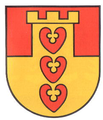Seeblatt
In coats of arms the sea leaf is shown as a stylized leaf of a water lily .
In older coat of arms descriptions it is also referred to as Mumblatt . As a three-pass , the sea leaves centered around a center, it was already known as a common figure in the Middle Ages . To distinguish it from the heart-shaped linden leaf, the stem is not shown, and the stem attachment is broken out like an ornament . Out of ignorance, it has been interpreted as Schröterhorn or also as a heart.
In the coat of arms, the arrangements are in piles , rows , obliquely left and obliquely right and are emblazoned in the description of the coat of arms . Other well-known arrangements are 2 over 1, but the sea leaf can also be found sown or scattered in coats of arms. More recent, mostly municipal coats of arms, represent both round and heart-shaped natural water lily leaves with a curved or twisted stem in coats of arms, which must be reported as such.
Cave : confusion with the chapels (similar to fallen sea leaves) and the Schröterhorns in the representation and designation is possible. Schröterhorn is often wrongly used for Seeblatt in blazonings . A sea leaf has a round or clover leaf breakout at the base of the stem, it is smaller and the surrounding area is larger than that of the chape . The chape symbolizes the lower fitting of a sword scabbard, and the Schröterhorn the stag beetle's pincers . The inaccuracies are marked, only the description of the coat of arms clarifies the facts.
three sea leaves on the left in the floating shield of the Bitterfeld coat of arms
two broken sea leaves in the coat of arms of Friesoythe
three golden sea leaves below in the coat of arms of the ancient district of Brilon
Coat of arms of Essen / Oldenburg
Coat of arms of Hermannstadt (Sibiu) in Transylvania
two natural sea leaves must be described in this way. Coat of arms of the municipality of Hohenpolding
in the district of Cloppenburg
Coat of arms of the city of Löhne (North Rhine-Westphalia), described as a Seeblatt, drawn as Schröterhorn
Coat of arms Kemberg with diamond wreath
Ornamentally cut sea leaf in the Prettin coat of arms
Original coat of arms of the Counts of Tecklenburg
Zwingenberg / Bergstrasse ; three silver lake leaves symbolize the location on the water (historical Neckar oxbow lake as a city moat) in the coat of arms














